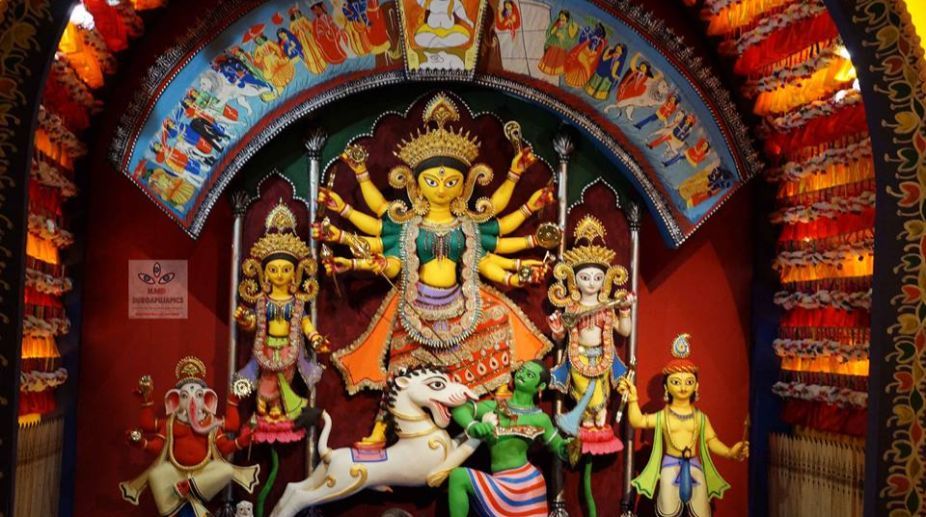Fervor marks Ram Navmi, the birth of Lord Rama, in Delhi
On the occasion of Ram Navami on Sunday, devotees were seen lining up in front of temples in Delhi, including the iconic Jhandewalan temple, in large numbers.

(Photo: Facebook)
Once the much awaited festival of Durga Puja arrives, it is welcomed with great pomp and enthusiasm, where the darkness of melancholy gets illuminated with the lights of happiness. With its advent we go back to our roots, traditions and culture.
For Bengalis it is not just a vacation for five days but the happiest time of the year. From food to fashion, shopping to pandal hopping, feeling elated on Mahalaya to being remorseful on Dashami, they experience it all to the fullest.
Advertisement
Certain things have evolved with time – people’s enthusiasm, the creativity of pandal making and the idols are being presented from modern perspectives. Yet in this age of modernisation, the ones which hold the traditional look since our grandfathers’ times, is effectively preserved by the bonedi families of Kolkata, for whom Durga Puja calls for devotion and enjoyment.
Advertisement
In the traditional style, the idols stand against a common backdrop known as ek chala (one-framed).
The way the corridors of these heritage houses lights up is beyond imagination and expression. For them the celebration starts from the time the idol is being made in the open courtyards of these houses.
The kids in the family builds castles of delight and wonder as they hear the mythological stories on Goddess Durga from their elders.
The families tend to attach a divine aura in the house since the occasion of Mahalaya welcoming the Goddess who is treated like the beloved daughter visiting her paternal house along with her children. For the four days, She is veiled with silver coloured strings called chikkan to keep her from curious eyes as was the tradition in old days. This concept was introduced in Sovabazar Rajbari where the then ruler used to import German silver for the purpose.
While talking about traditional Pujas, the Durga Puja at Sovabazar Rajbari must not be missed. It has a stark similarity with the one at Barabari in Santiniketan, not only in the looks of the palaces but also in the manner in which the rituals are followed.
All their distant relatives are united together during the entire span of the Puja and they celebrate it with great devotion, reverence and austerity. Many cultural events also take place in the lavish rooms of the Mahal.
With Mahalaya the idol comes to life in the backdrop of Sanskrit slokas as chanted by Birendra Krishna Bhadra.
The day signifies the beginning of the Puja as Navratri in the North Western part of India.
Finally with the arrival of Panchami, the women of these houses decks up in the traditional saris and the men in ‘dhoti’ and ‘punjabi’. With Durga Puja, the traditional richness of Bengal welcomes the global community at its doors.
The religious festival turns into a festival of the world. It’s the time when people from all religions enjoy pandal hopping to showcase their enthusiasm and ecstasy.
The occasion calls for a huge gathering where relatives from both home and abroad comes together to celebrate the grandeur.
Making of delicacies, advent of numerous guests with packets of sweets is something which all the children of the family look up to. The days of the puja, with its specialties like the Sandhi Puja and Pushpanjali, is all about excitement.
However, this gaiety ends with tears on the day of Dashami, when Goddess Durga with her children returns home.
The gala celebrations come to an end with sindur khela (a ritual where women smear vermillion on each other) as the idols are carried to the Ganges for immersion.
The festival ends with a perfect blend of joy, excitement and sorrow with the remorse chanting of “Bolo Dugga Mai ki … Joi” (all hail the Goddess).
(Sayan Chandra, Coordinator, Class XII,
St Thomas’ Boys’ School
Inputs by: Souromi Banerjee, Coordinator, Class XI,
Auxilium Convent School, Bandel)
Advertisement
On the occasion of Ram Navami on Sunday, devotees were seen lining up in front of temples in Delhi, including the iconic Jhandewalan temple, in large numbers.
Purify your home this Navratri with Patanjali’s Ayurvedic Havan Samagri. Experience positivity, peace, and a toxin-free environment.
The MLA says that the step will promote communal harmony and ensure smooth festivities
Advertisement
